Soldier Story: George Arthur, Jr. Buirkle
Soldier Story
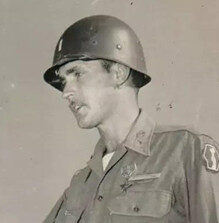
George Arthur Buirkle, Jr.
1st Lieutenant
442nd Regimental Combat Team
Cannon Company
George Arthur Buirkle, Jr. was born on December 16, 1918, in Columbus, Ohio. He was the second eldest and only son of George Arthur and Hilda Louise (Hansen) Buirkle. His siblings were: Anne, Ruth, Margaret Louise (died age 16), and Edna Barbara. George Sr. was born in New York. Mother Hilda was born in Wisconsin and her parents were immigrants from Norway.
In 1917, George’s parents were living in Connecticut when their first child Anne was born. Father George was a chain inspector. By late 1918, the family had moved to Columbus, Ohio, where father George was employed by Remington Arms. In 1920, he was a brakeman on the railroad and they were living on Cypress Avenue. By 1924, they had moved back to Bridgeport, Connecticut, were living at 963 Connecticut Avenue, and George was a foreman at American Chain Company.
In 1930, they were living at 5822 Homan Avenue in Chicago, Illinois, where George was employed as a manager (no company listed). By 1934, they had moved back to New York and George was employed as a watchman at a garage. He died of cancer on July 25, 1934. George Jr., a student at the New York School of Printing, left school to help support the family – he became a printer’s apprentice at a linotype business.
In 1940, the family was living at 1051 Union Avenue in the Bronx. Two of the elder daughters were employed as a bookkeeper and a billing clerk in addition to George Jr.’s continued employment at the linotype business.
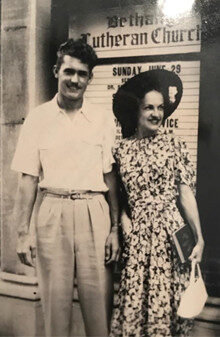
Later that year, George signed his draft registration card on October 16, 1940, Local Board 93, at New York Public School No. 23, East 165th and Union Street in the Bronx. He was 6’1” tall, weighed 160 pounds, and had brown hair and blue eyes. His mother was his point of contact, living at 966 Trinity Avenue. George had two crossed-out addresses written on his card – 966 Trinity and 1254 Franklin Avenue – and he lived at 928 East 159th Street. He was employed by A.O. Jennings Inc. at 52 Duane Street in Lower Manhattan.
Right: George and Margaret, June 29, 1941
On September 14, 1941, George married Margaret Rose Wolenter in New York. She was the daughter of John and Rose Wolenter, who arrived in 1913 as immigrants from Romania and Hungary, respectively.
When Pearl Harbor was attacked on December 7, 1941, George later recalled that he was at a New York Giants football game in New Jersey. He knew he wanted to do something for his country. He tried to enlist in the U.S. Coast Guard, but it entailed more paperwork than he could fit into his lunch break. He said that in those days there were no sick days, no vacation days, no time off. Many people were jobless and “You got only what you worked for.”
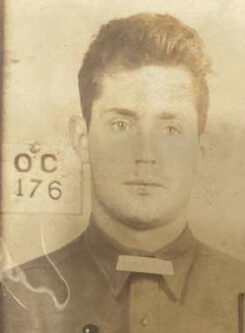
George Buirkle enlisted in the U.S. Army on April 10, 1942, at Fort Jay on Governor’s Island in New York. His occupation was listed as “Skilled compositor and typesetter.” He later recalled that he spent his early Army days doing such menial tasks as KP (kitchen police) duty, punching out dog tags, working as a waiter at the Officers Club, and studying field manuals to “try to get a jump on the future.” He volunteered for Officer Candidate School (OCS), passed the qualification tests, and was sent to Fort Benning, Georgia, for infantry training.
Left: Buirkle at time of entry to OCS
Upon graduation, 2nd Lieutenant Buirkle was assigned to the newly activated 442nd Regimental Combat Team at Camp Shelby, Mississippi. He reenlisted in the Army on February 19, 1943. He was in the training cadre that arrived at Camp Shelby the first half of February, and was there to greet the 2,686 new soldiers when they arrived from Hawaii on April 13. He trained L Company during basic training from May 10 to August 23. After a brief break so the men could have time for short passes and furloughs, the men returned and unit training was set to begin.
The 442nd had decided to activate a Cannon Company at the regimental level, which occurred on September 3. Six officers were chosen, among them Buirkle, and they selected 150 men from other companies to transfer to the new Cannon Company. It consisted of six light, truck-drawn, 105mm howitzers. This gave the regimental commander his own artillery that he could use when the Combat Team’s 522nd Field Artillery Battalion was firing another mission or needed additional support. In addition, Cannon Company could shoot under the direction of the 522nd’s Fire Direction Center as an extra firing battery.
Lt. Buirkle was assigned as a platoon leader in Cannon Company.
After nearly a year of training and field maneuvers, the 442nd left Camp Shelby on April 22, 1944, by train for Camp Patrick Henry, Virginia. On May 2, they sailed from nearby Hampton Roads in a convoy of over 100 ships bound for the Theater of War.
After a lengthy crossing, the 442nd arrived at Naples, Italy, on May 28 to join in the Rome-Arno Campaign. After two weeks at a bivouac in nearby Bagnoli at Staging Area No. 4, they left on LSTs and LCIs on June 6 and arrived at the recently liberated Anzio beachhead the next day. Finally, on June 9 they headed out in a convoy through the recently liberated city of Rome for their large bivouac in Civitavecchia, about 50 miles north. There they made final preparations to advance to the front lines.
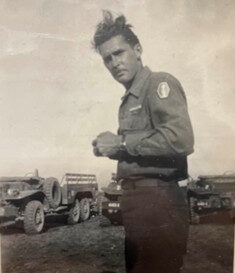
The 442nd entered combat on June 26, 1944, near Suvereto. They encountered some heavy fighting as they continuously pushed the Germans up the Italian peninsula. As they neared the city of Pisa, Lt. Buirkle told his superior officer that he wanted to shoot down the famous Leaning Tower of Pisa because the enemy was using it as an observation post. As he said, “No historical site is worth more than the lives of my men.” His request was denied.
Right: Buirkle during the convoy to the Vosges, 1944
In late September, the 442nd was sent to Naples for shipment to France, where they joined in the Rhineland-Vosges Campaign. They arrived at Marseilles on September 29 after a 2-day voyage, and bivouacked at nearby Septèmes prior to traveling over 500 miles north by truck or rail boxcars to the Vosges Mountains.
Lt. Buirkle was in combat for the next month during the bitter fighting to liberate the important road and rail junction of Bruyères, neighboring Biffontaine and Belmont, and the “Rescue of the Lost Battalion” – the 1st Battalion, 141st (Texas) Infantry that had advanced beyond the lines and was surrounded on three sides by the enemy.
The weather was cold, wet, snowy, and miserable, as the men fought in the heavily wooded forests still in their summer uniforms. They were subjected to living in wet foxholes, and incoming artillery raining down on them in “tree bursts.”
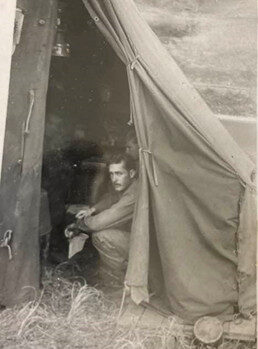
Finally, on November 17, the 442nd was relieved from the front lines after 25 days of heavy fighting, and sent to the south of France. There, they could rebuild to full combat strength while participating in the Rhineland-Maritime Alps Campaign, which was mostly a defensive position guarding the French-Italian border from incursion by the German Army in Italy.
Left: Buirkle, enroute to southern France, 1944
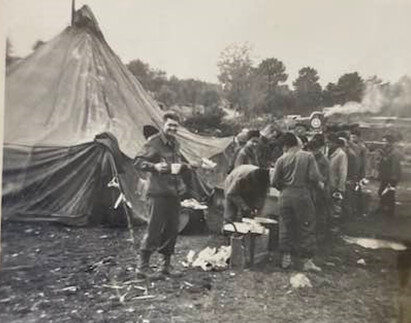
Above: Buirkle at Thanksgiving dinner, November 23, 1944
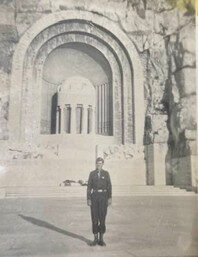
The 442nd was in the Maritime Alps Campaign beginning on November 23, 1944
While there, they often had short passes to spend time in Nice relaxing or sightseeing. For this reason, the men nicknamed this the “Champagne Campaign.”
Left: Buirkle sightseeing in Nice while on a furlough
On March 15, 1945, they were relieved and moved in relays to the new staging area at Marseilles. On March 20-22, the 442nd (without its 522nd Field Artillery Battalion who were sent to Germany) left France to fight in the Po Valley Campaign for the final push to defeat the Nazis in Italy. They arrived at the Peninsular Base Section in Pisa on March 25 and were assigned to Fifth Army. The 442nd fought in the Po Valley Campaign in what was supposed to be a diversionary attack up the west coast while the main thrust of the Allies in Italy was farther east.
The 442nd relentlessly pursued the enemy in their diversionary attack, resulting in a complete breakthrough of the Gothic Line in the west. Despite orders from Hitler to fight on, the German forces in Italy surrendered on May 2, 1945, a week before the rest of the German forces in Europe surrendered.
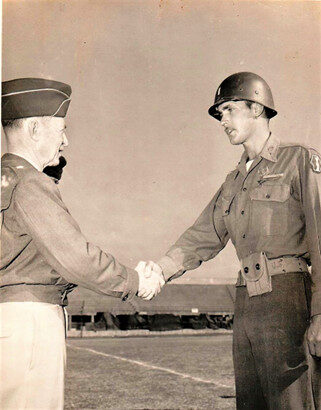
Buirkle served during the occupation when the 442nd was at Ghedi Airfield processing and guarding German prisoners of war, at Lecco, and then in the Livorno-Pisa area. During this time, he wrote to the Daily News in New York – to the “Little Old New York” columnist Ed Sullivan. His letter, which appeared in the September 30, 1945, edition, stated:
Right: Lt. George Buirkle receiving his Bronze Star Medal
Dear Ed, I am a member of this outfit [442nd RCT], which is composed of Americans of Japanese descent. I cannot tell you in words how much all of the Nisei officers and men of this unit appreciate all of your understanding of and sympathy for their problem. My sisters, who live in New York, send me your columns and I post them on the bulletin board to show the men that they have some good friends helping them in presenting the true picture of the gallantry of these Americans of Japanese descent. I have been with them since cadre days before the troops were assembled in Shelby, and truly I feel as one of them. Bless you for your fine attitude toward these boys because they truly deserve it.
Below: Buirkle during the Occupation in Italy, 1945
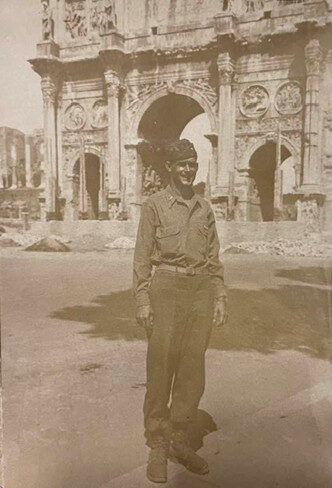
Buirkle returned home before the end of the year and was discharged from the U.S. Army on December 30, 1945.
For his military service in World War II, 1st Lt. George A. Buirkle, Jr. was awarded the: Bronze Star Medal with one oak leaf cluster, Purple Heart Medal, American Campaign Medal, European-African-Middle Eastern Campaign Medal with four bronze stars, World War II Victory Medal, Army of Occupation Medal, Distinguished Unit Badge, and Combat Infantryman Badge. He was awarded the Congressional Gold Medal on October 5, 2010, along with the other veterans of the 100th/442nd Regimental Combat Team. Conferred by the U.S. Congress, the award states: “The United States remains forever indebted to the bravery, valor, and dedication to country these men faced while fighting a 2-fronted battle of discrimination at home and fascism abroad. Their commitment and sacrifice demonstrates a highly uncommon and commendable sense of patriotism and honor.ˮ
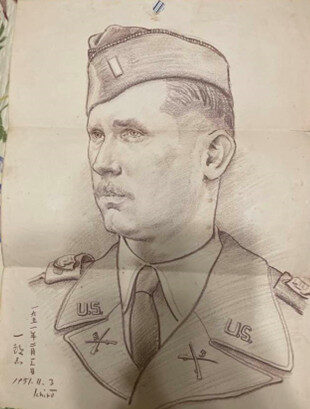
In 1950, the family was living at 193-01 122nd Avenue in Queens, New York. With them was Margaret’s widowed mother Rose Wolenter. George was a linographer and Margaret was a sales clerk at a department store. They later moved to Massapequa Park, Long Island, and raised a family of two daughters. He later served in the Korean War.
Right: Sketch by “442nd Officer Ichiro” on November 3, 1951, and given to Buirkle
After retiring in 1981, George and Margaret moved to Florida.
George Buirkle died on June 13, 1995, in Ocala, Florida. According to his obituary in Newsday – The Long Island Newspaper, he worked for 40 years as a typographer at Johnson/Kenroe in Freeport, Long Island. Survivors included his wife Margaret, two daughters, eight grandchildren, and eight great-grandchildren. The family held a memorial service on June 17 at Highland Baptist Church in Ocala. Margaret Buirkle died on June 14, 2017. Their ashes were spread in their beloved Adirondack Mountains.
Researched and written by the Sons & Daughters of the 442nd RCT with assistance by the family in 2025.